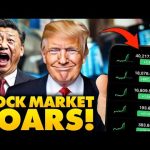President Donald Trump’s recent decision to implement a 90-day pause on certain tariffs has sparked intense debate among economists, political leaders, and business stakeholders. While the move temporarily eases tensions with some trading partners, it maintains the administration’s hardline stance against China, where tariffs have been raised to an unprecedented 125%. This dual approach underscores Trump’s strategy of leveraging tariffs as both a negotiating tool and a means to protect American industries, but it also raises questions about the broader economic consequences.
The pause on reciprocal tariffs, which were set to impact numerous nations with a baseline 10% rate, has provided temporary relief to global markets. Stock indices initially surged following the announcement, signaling investor optimism about reduced trade tensions. However, this optimism quickly faded as concerns over inflation and economic uncertainty resurfaced. Critics argue that while the pause might stave off immediate economic shocks, it does little to address the long-term challenges posed by Trump’s aggressive tariff policies.
At the heart of the controversy is the administration’s focus on China. By escalating tariffs to 125%, Trump aims to counter what he describes as Beijing’s “disrespect” for global markets and its exploitative trade practices. Supporters of this approach view it as a necessary step to curb China’s economic dominance and protect American jobs. However, opponents warn that such measures could backfire, leading to higher consumer prices and retaliatory actions that disrupt supply chains and hurt U.S. exporters.
The broader implications of Trump’s tariff strategy extend beyond economics. By prioritizing protectionist policies under his “America First” agenda, the president seeks to reshape global trade dynamics in favor of U.S. interests. Yet, this approach risks alienating allies and creating a fragmented international trade system. European leaders, for instance, have expressed frustration over being subjected to blanket tariffs despite their status as traditional U.S. partners.
As the 90-day pause unfolds, the administration faces mounting pressure to deliver tangible results in trade negotiations. Treasury Secretary Scott Bessent has praised Trump’s willingness to take bold action, emphasizing that the pause is part of a calculated strategy to secure better deals for American workers and businesses. However, with inflationary pressures looming and recession risks rising, critics argue that the administration must adopt a more targeted approach to avoid further economic fallout.
Ultimately, Trump’s tariff policies reflect his broader vision of economic nationalism—a vision that resonates with many working-class Americans who feel left behind by globalization. Whether this strategy will yield lasting benefits or exacerbate economic instability remains uncertain. For now, the U.S. finds itself at a crossroads in its trade relations, with high stakes for both domestic prosperity and global economic order.




